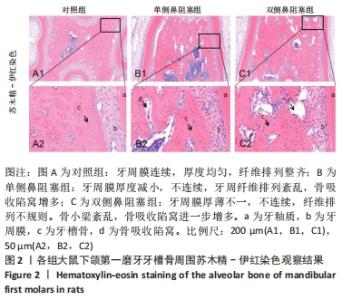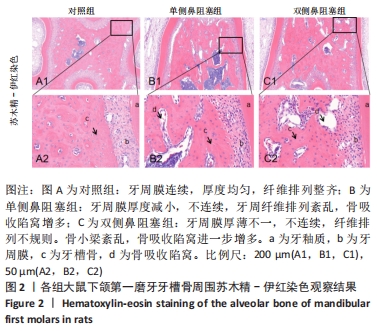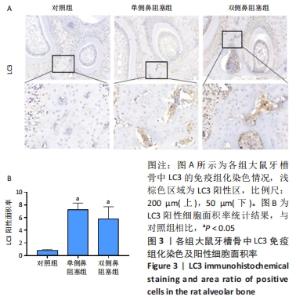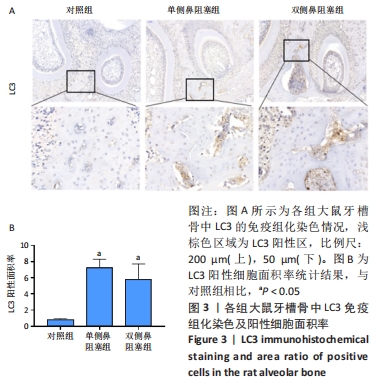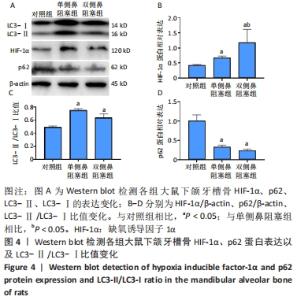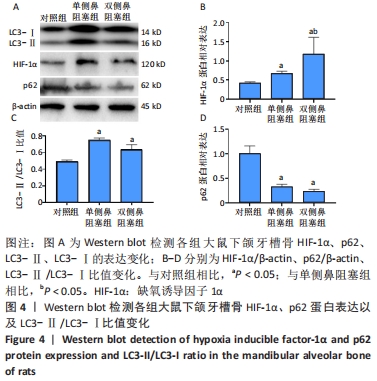[1] OISHI S, SHIMIZU Y, HOSOMICHI J, et al. Intermittent hypoxia induces disturbances in craniofacial growth and defects in craniofacial morphology. Arch Oral Biol. 2016;61:115‐124.
[2] SHER AE. Obstructive sleep apnea syndrome: a complex disorder of the upper airway. Otolaryngol Clin North Am. 1990;23(4):593-608.
[3] LYBERG T, KROGSTAD O, DJUPESLAND G. Cephalometric analysis in patients with obstructive sleep apnoea syndrome. I. Skeletal morphology. J Laryngol Otol. 1989;103(3):287-292.
[4] FANG Y, TAN J, ZHANG Q. Signaling pathways and mechanisms of hypoxia-induced autophagy in the animal cells Cell Biol Int. 2015;39(8): 891-898.
[5] SHAPIRO IM, LAYFIELD R, LOTZ M, et al. Boning up on autophagy: the role of autophagy in skeletal biology. Autophagy. 2014;10(1):7-19.
[6] 朱敏,陈金东,聂萍,等.间歇性双侧完全鼻阻塞的幼年大鼠模型的建立[J].中华口腔正畸学杂志,2014,21(2):91-94.
[7] HARARI D, REDLICH M, MIRI S, et al. The effect of mouth breathing versus nasal breathing on dentofacial and craniofacial development in orthodontic patients. Laryngoscope. 2010;120(10):2089-2093.
[8] GREENHILL C. Bone: Autophagy regulates bone growth in mice. Nat Rev Endocrinol. 2016;12(1):4.
[9] GAVALI S, GUPTA MK, DASWANI B, et al. Estrogen enhances human osteoblast survival and function via promotion of autophagy. Biochim Biophys Acta Mol Cell Res. 2019;1866(9):1498-1507.
[10] FLORENCIO-SILVA R, SASSO GR, SIMOES MJ, et al. Osteoporosis and autophagy: What is the relationship? Rev Assoc Med Bras. 2017;63(2): 173-179.
[11] AGOSTINHO HA, FURTADO IÃ, SILVA FS, et al. Cephalometric Evaluation of Children with Allergic Rhinitis and Mouth Breathing. Acta Med Port. 2015;28(3):316-321.
[12] MALHOTRA S, PANDEY RK, NAGAR A, et al. The effect of mouth breathing on dentofacial morphology of growing child. J Indian Soc Pedod Prev Dent. 2012;30(1):27-31.
[13] KOECKLIN KHU, KATO C, FUNAKI Y, et al. Effect of unilateral nasal obstruction on tongue protrusion forces in growing rats. J Appl Physiol. 2015;118(9):1128‐1135.
[14] HARVOLD EP, TOMER BS, VARGERVIK K, et al. Primate experiments on oral respiration. Am J Orthod. 1981;79(4):359-372.
[15] KUMA Y, USUMI‐FUJITA R, HOSOMICHI J, et al. Impairment of nasal airway under intermittent hypoxia during growth period in rats. Arch Oral Biol. 2014;59(11):1139‐1145.
[16] OISHI S, SHIMIZU Y, HOSOMICHI J, et al. Intermittent hypoxia induces disturbances in craniofacial growth and defects in craniofacial morphology. Arch Oral Biol. 2016;61:115‐124.
[17] LIONE R, BUONGIORNO M, FRANCHI L, et al. Evaluation of maxillary arch dimensions and palatal morphology in mouth-breathing children by using digital dental casts. IntJ Pediatr Otorhinolaryngol. 2014;78(1): 91-95.
[18] 赵婷婷,贺红,陈雄.颅颌面发育相关的阻塞性睡眠呼吸暂停低通气综合征动物模型研究进展[J].武汉大学学报(医学版),2020,41(2): 341-344.
[19] 陈金东,王晓玲,孙惠珺,等.间歇性双侧完全鼻阻塞对幼年大鼠下颌骨生长发育的影响[J].口腔医学,2016,36(11):993-996.
[20] LU HY, DONG F, LIU CY, et al. An animal model of obstructive sleep apnoea-hypopnea syndrome corrected by mandibular advancement device. Eur J Orthod. 2015;37(3):284-289.
[21] HOCKING LJ, WHITEHOUSE C, HELFRICH MH. Autophagy: a newplayer in skeletal maintenance? J Bone Miner Res. 2012;27(7):1439-1447.
[22] YAO W, DAI W, JIANG JX, et al. Glucocorticoids and osteocyte autophagy. Bone. 2013;54(2):279-284.
[23] SAINT-PASTOU TERRIER C, GASQUE P. Bone responses in health and infectious diseases: A focus on osteoblasts. J Infect. 2017;75(4):281-292.
[24] SHI J, WANG L, ZHANG H, et al. Glucocorticoids: Dose-related effects on osteoclast formation and function via reactive oxygenspecies and autophagy. Bone. 2015;79:222-232.
[25] NOLLET M, SANTUCCI-DARMANIN S, BREUIL V, et al. Autophagy in osteoblasts is involved in mineralization and bone homeostasis. Autophagy. 2014;10(11):1965-1977.
[26] CAMUZARD O, SANTUCCIDARMANIN S, BREUIL V, et al. Sex-specificautophagy modulation in osteoblastic lineage: a critical functionto counteract bone loss in female. Oncotarget. 2016;7(41): 66416-66428.
[27] LI DY, YU JC, XIAO L, et al. Autophagy attenuates the oxidative stress-induced apoptosis of Mc3T3-E1 osteoblasts. Eur Rev Med Pharmacol Sci. 2017;21(24):5548-5556.
[28] DESELM CJ, MILLER BC, ZOU W, et al. Autophagy proteinsregulate the secretory component of osteoclastic bone resorption. Dev Cell. 2011; 21(5):966-974.
[29] 万永鲜,徐丽丽,鲁晓波.自噬对骨质疏松症骨代谢的影响研究[J].中国骨质疏松杂志,2018,24(4):552-556.
[30] YAO W, DAI W, JIANG L, et al. Sclerostin-antibody treatment of glucocorticoid-induced osteoporosis maintained bone mass and strength. Osteoporos Int. 2016;27(1):283-294.
[31] 何正权,杨凯.大鼠正畸牙移动过程中压力侧牙周组织缺氧诱导因子-1α的表达[J].口腔疾病防治,2018,26(4):227-230.
|
